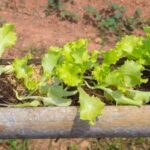Have you ever considered starting your own small vegetable garden at home? Whether you have limited space or simply want to enjoy the beauty of a mini garden, there are countless benefits to growing your own vegetables.
In this article, we will explore the world of small vegetable gardening and provide tips, ideas, and inspiration for creating and maintaining your very own mini garden. From choosing the perfect location to selecting the best vegetables and showcasing inspiring photos of small vegetable gardens, we will cover everything you need to know to get started on your small-space gardening journey.
Small vegetable gardens not only add visual appeal to your outdoor space but also provide an opportunity for you to grow fresh, organic produce right at home. With some creativity and careful planning, you can transform even the tiniest of spaces into a thriving garden filled with an abundance of delicious crops. In this section, we will discuss the beauty and benefits of small vegetable gardens, along with practical advice for making the most of limited space.
Whether you’re new to gardening or looking for innovative ideas to enhance your existing mini garden, this article will serve as your guide to creating a beautiful and productive small vegetable garden. So let’s dive in and discover how you can embrace the joy of small-space vegetable gardening through the following sections.
Choosing the Perfect Location
When it comes to creating a small vegetable garden, one of the most important factors to consider is the location. The right spot can make a significant difference in the success and productivity of your mini garden. Here are some tips for choosing the perfect location for your small vegetable garden:
1. Sunlight: Select a spot that receives plenty of sunlight, as most vegetables require at least 6-8 hours of direct sunlight daily. Take note of any structures or trees that may block sunlight and choose a location with maximum sun exposure.
2. Soil Quality: It’s essential to have good soil for a thriving vegetable garden. Test the soil in the area you’re considering and ensure it has good drainage and is rich in organic matter. If the soil quality is poor, consider using raised beds or containers with high-quality potting mix.
3. Accessibility: Choose a location that is easily accessible for watering, weeding, and harvesting. You’ll want to be able to tend to your mini garden without difficulty, so keep this in mind when selecting the spot.
By keeping these factors in mind, you can find the perfect location for your small vegetable garden and set it up for success. A well-chosen location will provide your mini garden with the sunlight, soil quality, and accessibility it needs to thrive and produce an abundance of fresh veggies.
Photos of small vegetable gardens showcasing optimum locations can provide inspiration for aspiring gardeners looking to create their own productive mini gardens in limited spaces. These images can serve as visual examples of how to effectively utilize different areas to grow vegetables while maximizing their potential for growth and harvest.
Selecting the Best Vegetables
When it comes to small vegetable gardens, choosing the right crops is crucial for a successful and productive harvest. Fortunately, there are plenty of vegetables that thrive in small spaces, making them perfect for your mini garden. Here are some options to consider:
- Leafy Greens: Vegetables like spinach, lettuce, and kale are excellent choices for small vegetable gardens. They don’t require a lot of space to grow and can even be grown in containers or vertical gardens.
- Compact Varieties of Tomatoes: If you’re a fan of tomatoes but have limited space, look for compact varieties that are specifically bred for small gardens. These tomatoes can be grown in pots or hanging baskets and still produce a bountiful crop.
- Herbs: Herbs such as basil, parsley, and chives are ideal for small gardens. They can be grown in shallow containers on a sunny windowsill or in a compact outdoor garden bed.
In addition to these options, other vegetables that do well in small spaces include radishes, carrots, peppers, and green onions. By carefully selecting your vegetable crops, you can maximize the productivity of your mini garden while enjoying a variety of fresh produce throughout the growing season.
Remember to consider the climate and growing conditions in your area when choosing which vegetables to plant in your small garden. With proper planning and care, you can create a thriving mini garden filled with an array of delicious and nutritious vegetables. And if you need inspiration, take a look at some photos of small vegetable gardens to see how others have successfully cultivated their own little patches of greenery.
Container Gardening
When it comes to small vegetable gardens, container gardening is a popular and practical option for maximizing limited space. Whether you have a small patio, balcony, or even just a windowsill, container gardening allows you to grow your favorite vegetables without the need for a traditional garden plot. With the right containers and some creative planning, you can create a thriving mini garden that yields an abundance of fresh produce.
Selecting the Right Containers
When it comes to container gardening for small vegetable gardens, choosing the right containers is essential. Look for pots or containers that are large enough to accommodate the root systems of your chosen vegetables. Additionally, make sure that the containers have adequate drainage to prevent waterlogged soil, which can lead to root rot. You can use a variety of containers such as pots, planters, hanging baskets, or even repurposed items like buckets or barrels.
Choosing the Best Vegetables for Container Gardening
Not all vegetables are well-suited for container gardening, so it’s important to choose crops that thrive in confined spaces. Some great options for small vegetable gardens include tomatoes, peppers, lettuce, spinach, radishes, green onions, and herbs such as basil and parsley. When selecting vegetables for your container garden, consider the mature size of the plants and their sunlight requirements to ensure they will be successful in containers.
Creative Layouts and Arrangements
One of the benefits of container gardening is the flexibility it offers in terms of layout and arrangement. Get creative with your design by mixing different types of containers and arranging them in interesting configurations. You can also add visual interest by incorporating trellises or vertical structures for climbing plants like cucumbers or peas. By thinking outside the box and utilizing vertical space effectively, you can make the most of your limited space and create a beautiful small vegetable garden.
By embracing container gardening techniques and getting creative with your layout and plant selection, you can make the most of limited space and enjoy a bountiful harvest from your small vegetable garden. Whether you’re growing on a balcony, patio, or windowsill, container gardening offers endless possibilities for cultivating fresh produce in even the smallest of spaces.
Photos of small vegetable gardens are great examples of how container gardening can be used creatively to maximize space while still producing an abundance of fresh vegetables. These inspirational images showcase various techniques for arranging containers and growing a diverse range of crops in limited areas. From colorful patio gardens to compact window boxes overflowing with herbs and greens – these photos serve as motivation for anyone looking to embark on their own small-space vegetable gardening adventure.
With some planning and creativity using containers, you too can create a beautiful and productive mini garden regardless of how much space you have available.
DIY Garden Design
Designing a small vegetable garden can be an enjoyable and creative process. With limited space, it’s essential to maximize every inch of your mini garden to ensure a bountiful harvest. When planning the layout of your small vegetable garden, consider the types of vegetables you want to grow, as well as the available space and sunlight in your chosen location.
One popular and effective idea for small vegetable gardens is raised bed gardening. Raised beds provide better drainage, soil quality, and organization for your crops. Additionally, they can be built in various shapes and sizes to fit any space. Utilizing vertical gardening techniques is another great way to make the most of limited space. Growing vegetables such as tomatoes, cucumbers, and peas on trellises or supports not only saves space but also makes harvesting easier.
When designing the layout of your mini garden, consider interplanting compatible vegetables together. For example, planting lettuce between rows of carrots or radishes can maximize space and create a visually appealing garden design. Furthermore, incorporating pathways between garden beds or containers can help with accessibility for maintenance tasks like watering and weeding.
To add visual interest to your small vegetable garden, consider incorporating decorative elements such as ornamental plants, flower borders, or even artistic features like painted rocks or colorful signage. These creative touches can enhance the aesthetics of your mini garden while still prioritizing functionality and productivity.
| Small Vegetable Garden Design Ideas | Description |
|---|---|
| Raised Bed Gardening | Effective for better drainage and soil quality. |
| Vertical Gardening | Utilizes vertical space for growing crops such as tomatoes and cucumbers. |
| Interplanting Techniques | Maximizes space by planting compatible vegetables together. |
Maintenance and Care
Maintaining a small vegetable garden may seem like a daunting task, but with the right tips and tricks, it can be a rewarding and enjoyable experience. One of the most important aspects of caring for your mini garden is regular watering and proper sunlight.
Most vegetables need at least 6 hours of sunlight per day, so be sure to place your garden in an area that receives adequate light. Additionally, watering should be done consistently to keep the soil moist but not waterlogged.
Another crucial aspect of maintenance is pest control. Whether you’re dealing with pesky insects or furry critters, it’s important to take measures to protect your plants. Consider using natural insect repellents or physical barriers such as mesh netting to keep unwanted visitors at bay. Regularly inspecting your plants for signs of infestation or disease can also help you catch and address issues before they spiral out of control.
In addition to these tasks, regular weeding and pruning are essential for keeping your small vegetable garden healthy and productive. Weeds compete with your crops for nutrients and water, so it’s important to remove them regularly. Furthermore, pruning allows for better air circulation around the plants and helps prevent disease. By staying on top of these maintenance tasks, you can ensure that your mini garden thrives and yields a bountiful harvest.
| Maintenance Tasks | Importance |
|---|---|
| Watering | Keeps soil moist without overwatering |
| Pest Control | Protects plants from damage |
| Weeding and Pruning | Prevents competition for nutrients and disease |
Harvesting and Enjoying the Fruits of Your Labor
Once you have successfully planted and cared for your small vegetable garden, it’s time to reap the rewards of your hard work. Harvesting the fruits (and vegetables) of your labor can be an incredibly satisfying and fulfilling experience. Not only do you get to enjoy the literal fruits of your labor, but you also get to savor the delicious, fresh produce that you have cultivated with care.
Timing Is Key
When it comes to harvesting from your small vegetable garden, timing is key. Different vegetables have different harvesting times, so it’s important to keep an eye on the progress of your crops. Harvesting at the right time ensures that you get the best flavor and nutritional value from your produce.
Enjoying Your Fresh Bounty
One of the greatest joys of small-space vegetable gardening is being able to enjoy fresh, homegrown produce straight from your garden. Whether it’s a crisp salad made from freshly picked lettuce and tomatoes or a hearty stir-fry using vegetables from your garden, savoring the flavors of your own harvest is incredibly rewarding.
Sharing Your Harvest
If your small vegetable garden yields more produce than you can consume on your own, consider sharing the bounty with friends, family, or neighbors. Sharing the fruits of your labor not only spreads joy and good food but also fosters a sense of community and connection. Plus, there’s something special about being able to share homegrown vegetables with loved ones.
Showcasing Small Vegetable Gardens
As the saying goes, “a picture is worth a thousand words,” and when it comes to small vegetable gardens, this couldn’t be more true. Showcasing inspiring photos of beautiful and productive mini gardens can provide valuable insight and inspiration for individuals looking to start their own small-scale gardening projects.
These visual representations can offer a glimpse into the creative layouts, diverse crop selections, and effective container gardening techniques that can make small vegetable gardens both practical and aesthetically pleasing.
Photos of small vegetable gardens can showcase how a tiny balcony, patio, or even windowsill can be transformed into a thriving green space filled with colorful produce. From compact raised beds to vertical garden structures, these images demonstrate how to make the most of limited space by using innovative design concepts such as companion planting and intercropping. Additionally, these photos can highlight the beauty of small-scale gardening equipment and tools specifically designed for urban or small-space gardening.
Moreover, showcasing photos of small vegetable gardens provides an opportunity to celebrate the joy and satisfaction that comes with growing one’s own food in a limited space. These images capture not only the physical beauty of flourishing plants but also the sense of accomplishment and connection to nature that many individuals experience through cultivating their own mini garden.
Whether it’s bountiful harvests of vibrant tomatoes, peppers, herbs, or lettuces, these photos serve as a reminder that even the tiniest of spaces hold great potential for abundant growth and enjoyment.
Conclusion
In conclusion, embracing the joy of small-space vegetable gardening can be a rewarding and fulfilling experience. Whether you have a tiny backyard, a balcony, or even just a windowsill, there are endless possibilities for growing your own fresh produce. Small vegetable gardens not only add natural beauty to your surroundings but also provide numerous benefits such as access to fresh and organic vegetables, the opportunity for physical activity, stress reduction, and an overall sense of accomplishment.
By following the tips and techniques outlined in this article, anyone can create a thriving mini garden regardless of space limitations. From selecting the right location and vegetables to utilizing container gardening and clever DIY garden designs, there are countless ways to make the most of your small space.
The photos featured in this article serve as inspiration for what is possible with limited area – from vertical garden walls to window box herb gardens, these images showcase the potential beauty and productivity of small vegetable gardens.
In the end, small-space vegetable gardening is about more than just growing food; it’s about nurturing life and connecting with nature in a meaningful way. So whether you’re an experienced gardener or new to the world of horticulture, consider starting your own mini garden today and enjoy the satisfaction of watching your efforts blossom into delicious rewards. With dedication and creativity, anyone can cultivate a flourishing oasis of greenery in their own small corner of the world.
Frequently Asked Questions
How Do You Layout a Small Vegetable Garden?
Layout a small vegetable garden by first choosing a sunny spot with good drainage. Use raised beds or containers to maximize space and make it easier to manage. Arrange the plants in a way that allows for easy access and regular maintenance.
What Are the Best Vegetables to Grow in a Small Garden?
The best vegetables to grow in a small garden are those that can be easily grown in containers or raised beds, such as tomatoes, peppers, lettuce, spinach, radishes, and herbs like basil and cilantro. These vegetables don’t take up much space but still provide a bountiful harvest.
What Vegetables Are Good for Small Spaces?
Vegetables that are good for small spaces include compact varieties of tomatoes, such as cherry or grape tomatoes, bush varieties of cucumbers and zucchinis, small-space peas and beans, mini bell peppers, and dwarf varieties of eggplant. These vegetables are perfect for growing in limited space without sacrificing yield.

If you’re looking to get into vegetable gardening, or are just looking for some tips on how to make your current garden better, then you’ve come to the right place! My name is Ethel and I have been gardening for years. In this blog, I’m going to share with you some of my best tips on how to create a successful vegetable garden.





